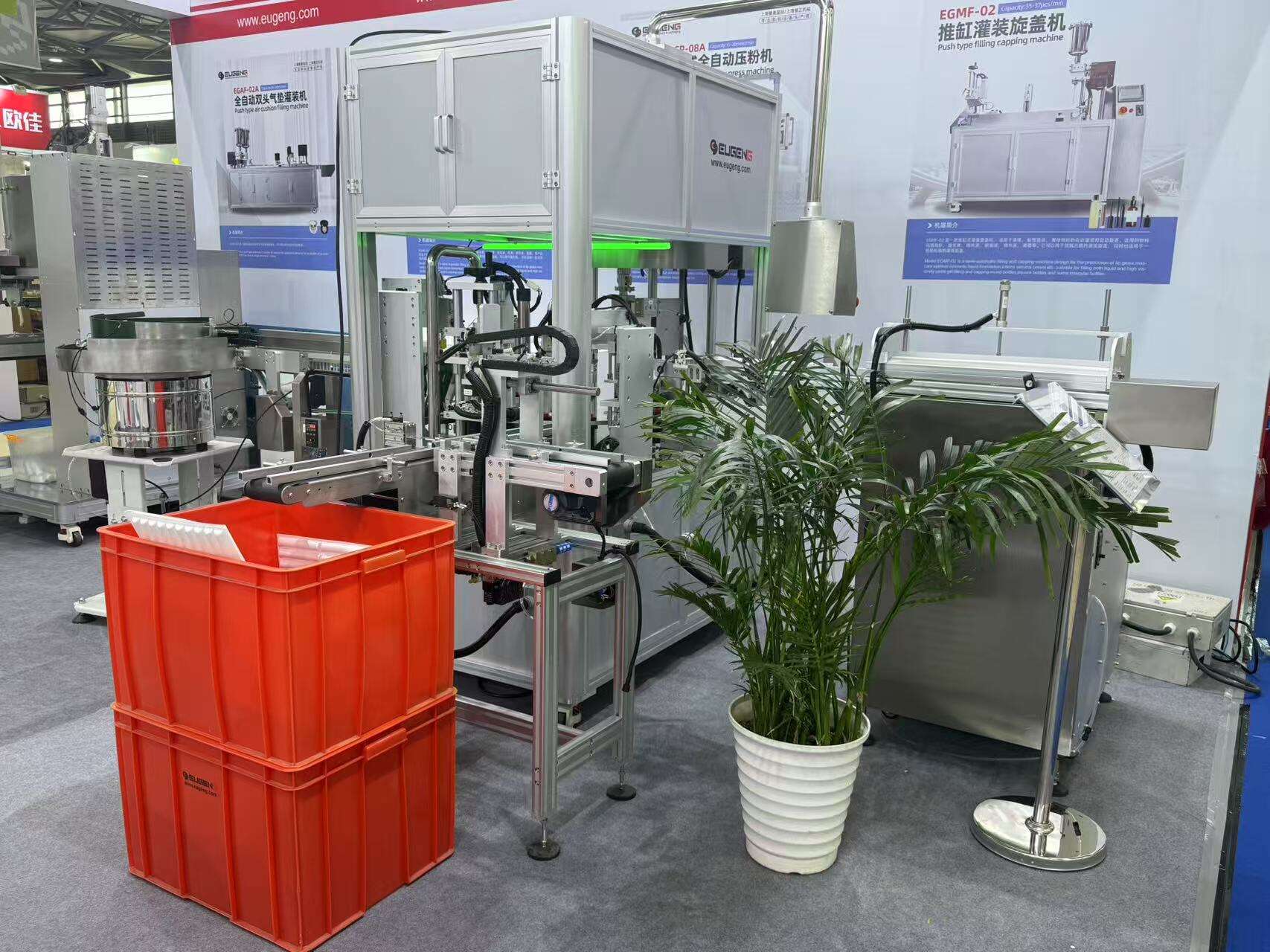Key Features of Modern Filling and Capping Machines
Precision Liquid Filling Mechanisms
Precision in liquid filling is crucial for minimizing waste and ensuring product consistency. By maintaining accurate filling measures, manufacturers can significantly reduce overfill or underfill issues, leading to lower material costs and improved customer satisfaction. Technologies such as volumetric pumps, piston fillers, and time-pressure fillers are pivotal in achieving this level of precision. For example, volumetric pumps provide exact measurements for each filling operation, which are especially beneficial for high-value liquids like pharmaceuticals. According to a report by the International Federation of Robotics (IFR), advances in these technologies have led to a notable decrease in production costs, enhancing product profitability and consumer trust.
High-Speed Rotary Capping Systems
High-speed rotary capping systems greatly enhance the efficiency of the capping process by improving speed and precision. These systems offer features such as adjustable cap sizes and automated cap feeding, enabling seamless operation across different product lines and reducing downtime. With the ability to achieve impressive throughput rates, these systems are ideal for large-scale productions where time and accuracy are critical. Key metrics highlight that advanced rotary capping systems can manage speeds of up to 600 caps per minute, significantly boosting production rates and operational efficiency compared to traditional capping methods.
Integrated Quality Control Sensors
Quality control sensors play a vital role in ensuring product integrity and compliance with industry standards by monitoring different aspects of the filling and capping processes. These sensors, including fill level and cap tightness detectors, provide real-time data to ensure that each packaged product meets specific quality criteria. Advanced sensors have been shown to substantially reduce defect rates; for instance, employing fill level sensors can decrease the occurrence of overfilled containers. According to industry data, manufacturing defect rates have dropped as much as 30% in factories that incorporate integrated quality control systems, consequently enhancing product reliability and consumer satisfaction.
How Automatic Systems Enhance Production Efficiency
Reduced Human Error in Sealing Processes
Automation plays a critical role in minimizing errors during the sealing processes in packaging. By replacing manual operations with automated systems, the likelihood of mistakes caused by human fatigue, distraction, or skill variation is significantly reduced. Common errors such as improper sealing can lead to product contamination or reduced shelf-life, impacting overall production quality and consumer satisfaction. Implementing automation in sealing has resulted in an observable decline in error rates. For example, studies show a reduction of errors by up to 40% in the sealing processes post-automation. As automation continues to evolve, we can expect even greater improvements in efficiency and error management.
24/7 Operation Capabilities
One of the most significant advantages of automatic filling and capping machines is their ability to operate continuously, 24/7. This uninterrupted operation boosts production output, allowing facilities to meet growing demands without additional human resources. Continuous operation significantly enhances profitability, as machines maintain high levels of efficiency without the downtime required for human workers. Statistics demonstrate that production capacity can increase by as much as 20% when machines operate continuously. This not only leads to faster fulfillment of orders but also optimizes cost management, contributing to long-term business success.
Industries Benefiting from Automated Filling Solutions
Pharmaceutical Applications for Sterile Packaging
Automated filling solutions are essential for maintaining sterile packaging in pharmaceutical applications. In an industry where contamination can have significant adverse effects, automation ensures the precision needed for sterile environments. Automated systems comply with stringent health regulations, reducing human error and enhancing pack integrity. Demand within this sector is growing; according to industry data, automation in pharmaceuticals is expected to expand significantly, driven by increased regulatory complexities and production sizes. These automated solutions not only meet compliance but also foster scalable production processes.
Beverage Industry Bottling Innovations
The beverage industry is observing remarkable innovations due to automated filling and capping technology. Brands are increasingly adopting automatic systems to enhance packaging efficiency and reduce labor costs. Notable examples include companies that have revamped their operations with state-of-the-art equipment, resulting in heightened output and operational speed. For instance, specific brands have reported efficiency gains that have positively impacted market performance. According to recent statistics, such technological advancements in automation have boosted production capacities substantially, altering the competitive landscape.
Cosmetics and Chemical Product Lines
Automation in cosmetics and chemical production lines addresses unique challenges associated with the varied viscosities of products. Automated systems ensure precision in filling, catering to the specific demands of these industries. Advanced capping technologies are also pivotal, ensuring chemical safety and product integrity. Manufacturers witnessing these advancements often share satisfaction over improved performance metrics. Case studies highlight the positive responses from industries leveraging these technologies, emphasizing their utility in meeting stringent quality standards and increasing production reliability.
Technological Advances in Capping Machine Automation
Smart Torque Control for Consistent Seal Integrity
Smart torque control plays a crucial role in maintaining seal integrity, ensuring that capping machines apply consistent pressure for optimal sealing. This technology adjusts torque settings based on different cap materials, promoting uniform sealing across varied applications. By implementing smart torque control, businesses report enhanced sealing effectiveness, minimizing leakage and contamination. For instance, a study showed improvements in seal performance by up to 30% after integrating smart torque technologies into production lines. This advancement underscores the importance of adaptive torque settings in achieving reliable packaging under diverse conditions.
AI-Driven Predictive Maintenance
AI-driven predictive maintenance significantly reduces downtime in production, making it a cornerstone technology in modern capping machine automation. By analyzing real-time data, AI algorithms forecast maintenance needs, allowing timely interventions before faults occur. This proactive approach not only saves costs associated with machine breakdowns but also enhances operational efficiency. Statistics reveal a reduction in average maintenance costs by approximately 40% after implementing AI solutions. With these benefits, companies experience uninterrupted production flow and increased machine lifespan, emphasizing AI's role in revolutionizing the maintenance landscape.
Selecting the Right Equipment for Your Production Line
Throughput Requirements vs. Machine Specifications
Aligning throughput requirements with machine specifications is crucial for optimizing production efficiency. By ensuring that a machine's capabilities meet the production line's demands, businesses can avoid bottlenecks and ensure smooth operations. Industry standards often guide these decisions, suggesting that, for instance, a filler machine should match a facility's hourly volume needs to prevent excess wear and tear. Successful alignments can significantly enhance production efficacy; an exemplary case is a beverage manufacturer pairing an automatic filling machine with its rapid throughput line, resulting in a marked decrease in downtime and operational costs. By thoughtfully selecting equipment that meets specific productivity goals, companies can enhance their overall production efficiency and profitability.
FAQ Section
What are the benefits of precision liquid filling mechanisms?
Precision liquid filling mechanisms reduce waste, ensure product consistency, and lower material costs by preventing overfill or underfill issues, thus enhancing customer satisfaction.
How do high-speed rotary capping systems improve production?
High-speed rotary capping systems increase efficiency by allowing adjustable cap sizes and automated feeding, achieving up to 600 caps per minute, ideal for large-scale productions.
Why are integrated quality control sensors important?
They ensure product integrity and compliance by providing real-time data on fill levels and cap tightness, reducing defect rates and improving consumer satisfaction.
How does automation reduce human error in sealing processes?
Automation minimizes errors from human fatigue or distraction, leading to fewer errors in sealing, thus reducing contamination and improving product shelf-life.
What industries benefit most from automated filling solutions?
Industries such as pharmaceuticals, beverages, cosmetics, and chemicals greatly benefit, as automation ensures precision, reduces labor costs, and meets regulatory standards.
Table of Contents
- Key Features of Modern Filling and Capping Machines
- How Automatic Systems Enhance Production Efficiency
- Industries Benefiting from Automated Filling Solutions
- Technological Advances in Capping Machine Automation
- Selecting the Right Equipment for Your Production Line
-
FAQ Section
- What are the benefits of precision liquid filling mechanisms?
- How do high-speed rotary capping systems improve production?
- Why are integrated quality control sensors important?
- How does automation reduce human error in sealing processes?
- What industries benefit most from automated filling solutions?

 EN
EN
 AR
AR BG
BG HR
HR CS
CS DA
DA NL
NL FI
FI FR
FR DE
DE EL
EL HI
HI IT
IT JA
JA KO
KO NO
NO PL
PL PT
PT RO
RO RU
RU ES
ES SV
SV TL
TL IW
IW ID
ID LV
LV LT
LT SR
SR UK
UK VI
VI HU
HU TH
TH TR
TR FA
FA MS
MS UR
UR BN
BN LO
LO LA
LA PA
PA
